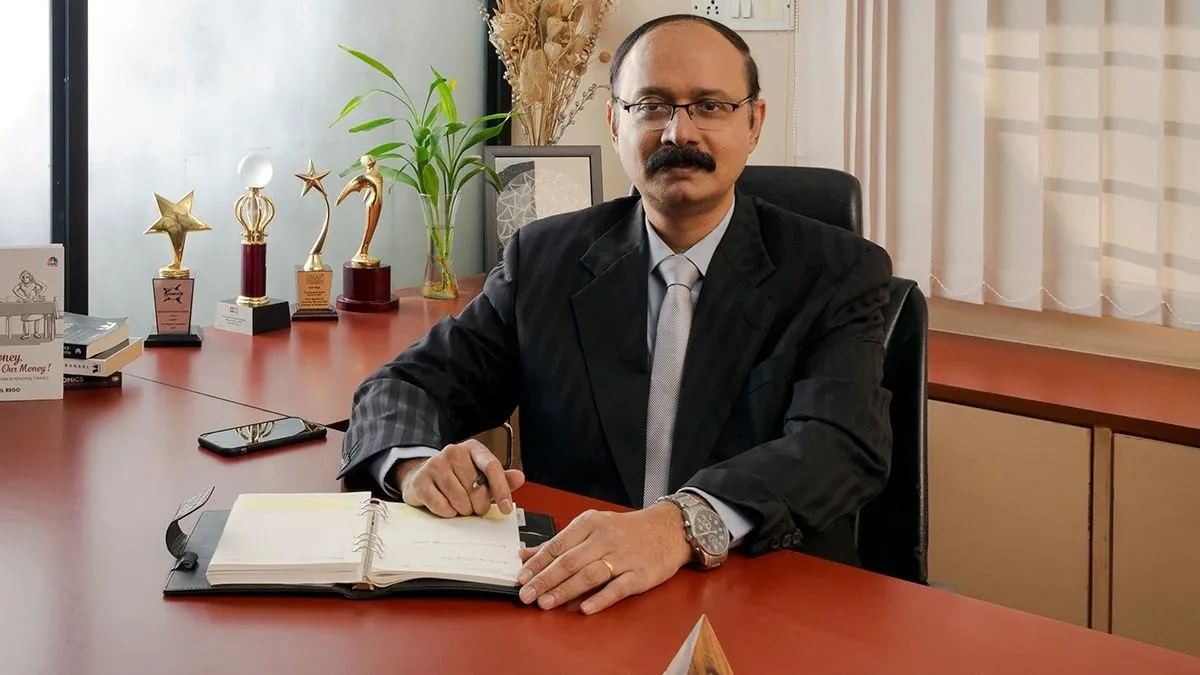Market News
IT sector to benefit from strong growth in the US; have modest expectations for markets: Anil Rego, Founder, Right Horizons

11 min read | Updated on January 27, 2025, 15:17 IST
SUMMARY
"Amid the backdrop of moderating earnings growth, mounting global headwinds, and stretched valuations, we see reasonable valuations in large caps and select SMIDs and have modest expectations for the markets," says Anil Rego, founder and fund manager at Right Horizons PMS.

Anil Rego, founder and fund manager at Right Horizons PMS
In Q4CY24, the exuberance gave way to uncertainty, as global headwinds and concerns over expensive valuations took their toll, with the Sensex declining sharply by 7.3%. The narrative changed from a continuance in the momentum of the capex upcycle with earnings holding up despite a weak top line to moderating profit growth as credit costs and input prices have bottomed out, limiting margin expansion.
Amid the backdrop of moderating earnings growth, mounting global headwinds, and stretched valuations, we see reasonable valuations in large caps and select SMIDs and have modest expectations for the markets.
We believe that valuations are notoriously ineffective for predicting short-term returns but are salient at extremes. We have observed that high valuation regimes can persist for extended periods and typically pose no hindrance until they reach excessive levels.
We believe domestic equities command premium valuations relative to major peers, supported by healthy corporate earnings, return on equities (ROEs), and decadal low FII holdings. Government capex was limited in H1FY25 and is expected to pick up in H2; additionally, the rate cut cycle is expected to commence in 2025, which will aid domestic equities.
We believe multiple expansions will be limited for the market, and earnings growth is likely to be the primary driver of returns.
In the pre-budget talks with trade unions and the energy, infrastructure, and urban development sectors, key demands included increasing the minimum EPFO pension fivefold to ₹5,000 per month, enhancing the income tax exemption limit to ₹10 lakh annually, scrapping the new pension scheme and unified pension scheme, reinstating the old pension scheme, and introducing an additional 2% tax on the super-rich to ensure social security for all informal work.
We do not anticipate significant policy announcements in Budget 2025. Given the prevailing political stability, the budget is likely to emphasise the government's dedication to fiscal discipline, aiming to meet its fiscal deficit targets. We expect sustained investments in infrastructure.
In H1 2024-25, YOY real GDP growth slowed to 6.0%, down from 8.2% in H1 FY24. On the macroeconomic front, the economy is projected to remain robust, with GDP growth anticipated at 6.7% in FY26 compared to 6.6% in FY25E, though risks persist due to weak urban demand and sluggish private capital expenditure growth.
Real GDP growth is anticipated to rebound in H2 of the current financial year, driven by a recovery in domestic factors such as increased public consumption and investment, robust service exports, and favorable financial conditions.
Inflation is projected to decline to around 4.1% in FY26, boosting consumer purchasing power from its current subdued levels. The FY26 Union Budget is expected to emphasise capital expenditure; however, fiscal prudence and a high base could limit its growth. Furthermore, the RBI is anticipated to begin its much-awaited interest rate cut cycle in CY25, further aiding growth.
The Reserve Bank of India forecasts a 6.6% GDP growth rate for FY25, reflecting a recovery path after the economic slowdown observed in the first half of the fiscal year. Government capital expenditure witnessed slower momentum in H1FY25. However, we expect a pickup in H2 of FY25, and FY26 is likely to see a more balanced distribution of government capex spending driving infrastructure and related sectors such as roads, housing, logistics, and railways.
A cyclical recovery in domestic demand, combined with increased capacity utilisation in the manufacturing sector, could lead to the realisation of several private capital expenditure plans. We expect headline retail inflation to head into RBI’s target range in FY26 and the rate cut cycle to begin by the end of FY25 or at the beginning of FY26.
We expect economic growth to trend higher in 2025, supported by recovering domestic demand with a pick-up in government spending and improvement in private consumption on improving prospects for rural incomes as key support.
We believe the macroeconomic environment is favorable for equities, with improving economic growth, increased government spending, and the start of the RBI’s policy easing cycle creating a positive outlook. We see stretched valuations in the broader segment, and amid moderating earnings expectations, we believe earnings growth would be the primary driver of returns.
We are of the view that selective opportunities in quality SMID segments with healthy earnings growth outlooks that are available at discounts will do better going forward.
We project growth of 10-11% in the headline indices, reflecting a stable uptrend supported by improving economic indicators, corporate resilience, and favorable policies. The mid-cap segment is expected to outperform with anticipated growth of 15-16%, driven by its agility and ability to capitalize on emerging market opportunities in high-potential sectors. This underscores growing investor confidence in mid-sized enterprises as key drivers of innovation and growth.
However, with near-term market volatility, any correction triggered by external factors could offer a strategic entry point for investors. While the earning potential of mid- and small-caps is superior, their current valuations are stretched. Investors should exercise caution, rationalising their portfolios to strike a balance between seizing growth prospects and managing inherent risks. A disciplined approach will help navigate uncertainties while positioning for long-term gains.
It's prudent for investors to adopt a diversified investment strategy that balances risk and potential returns without overconcentrating on any asset class.
We anticipate that India's growth and corporate earnings (although moderating relative to FY20-FY24 but healthy) will be driven by increased government spending and a rebound in consumption demand, supported by the initiation of the rate cut cycle. We maintain an overweight position in equities, prefer medium- and long-maturity bonds in fixed income, and regard gold as an essential hedge for the portfolio.
Unlike the 2000s, India's bull market in the 2020s is distinct from other emerging markets. This divergence is not driven by a higher GDP growth differential, but rather by an improved earnings differential. The shift from an uptrend in the capex cycle to moderation in profits warrants one to be selective and focus on businesses.
We focus on themes with unique growth drivers:
Hospitals are benefiting from cash flows that significantly exceed regular capex, enabling faster growth. In the consumption investment landscape, the sector is rich with quality franchises and remains a key focus area, especially in the gold segment.
We prefer quality companies with healthy unit economics and SSSG, which are anticipated to become consistent compounders.
Urban areas, which represent 50-60% of FMCG sales, have faced pressure due to several factors: 1) A slowdown in discretionary spending, 2) modest wage growth, 3) higher interest rates along with rising rental costs and EMIs, and 4) increased competition from other D2C brands as Q-commerce penetration grows, contributing to overall weakness in urban markets.
Indian FMCG companies are experiencing a structural growth trajectory. India's consumer landscape is experiencing a major shift, fueled by rising disposable incomes, urbanisation, and evolving lifestyles. A key trend is a move toward premiumisation, with consumers increasingly favouring high-quality, branded products and services. Additionally, the shift from unorganised to organised segments in favour of branded products is aiding well for the consumer sector.
We anticipate that volume growth is expected to gradually improve in the second half of the year, driven by the festive season.
India's swift urbanisation and highly fragmented retail sector have created the perfect conditions for the growth of quick commerce. The success of quick commerce depends on streamlining the supply chain and improving channel efficiency to minimise delivery costs.
As the sector grows, product offerings are broadening beyond food and grocery, increasing average order values and enhancing unit economics. Leveraging consumer data to include long-tail SKUs improves inventory management. Scaling further unlocks sourcing benefits and opens opportunities to diversify into services.
We believe quick commerce is transforming India's retail supply chain by streamlining distribution channels, enabling new brands to gain greater visibility and compete more effectively on price.
The wealth management sector in India has demonstrated a strong potential for growth. The following points are to be considered:
-
Rising Wealthy Population: The number of high-income individuals (earning >₹50 million annually) in India has been growing significantly.
-
Low Professional Management of Wealth: Only 15% of financial wealth in India is professionally managed, compared to 75% in mature markets.
-
Untapped Potential: The disparity highlights a substantial growth opportunity for wealth management firms to cater to this underpenetrated market.
-
Current Financial Assets: HNIs and UHNIs held a combined financial asset base of USD 1.2 trillion in 2023. This asset base is projected to grow to USD 2.2 trillion by 2028, reflecting significant expansion. The rapid growth underscores a lucrative opportunity for wealth management and financial advisory services in India.
Since the pandemic, investment trends have shifted significantly due to changes in consumer behavior, economic policies, and market dynamics.
We follow Growth at reasonable valuation (GARV), which is a fundamental-driven investment strategy that balances growth and tends to invest in high-growth, reasonably valued stocks that are trading at a discount to the fair value.
Primarily, the GARV strategy favours investing in companies with consistent earnings and sales growth, reasonable valuation proving sufficient margin of safety, and solid financial strength.
Since we are bottoms-up stock pickers, we are selective in picking stocks and only add companies with healthy long-term earnings growth visibility that are at reasonable prices. In that sense, we have positioned our portfolio with selective quality names in the SMID space where we expect earnings to grow sustainably over the next 3-5 years wherein structural trends are prevalent.
About The Author
Next Story

